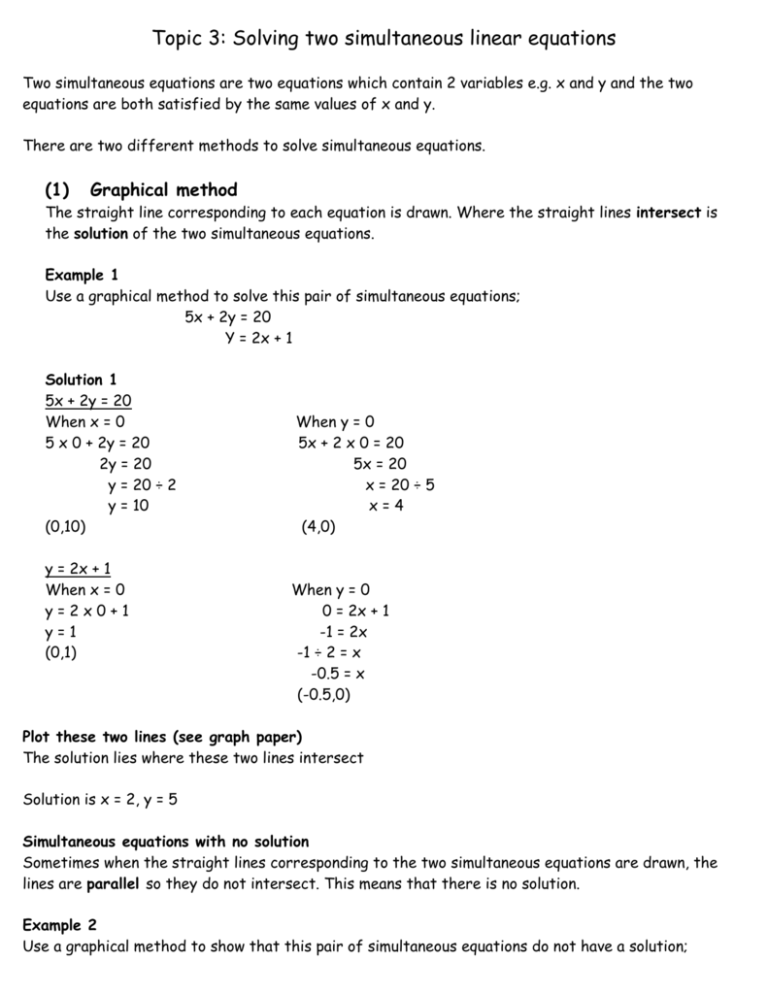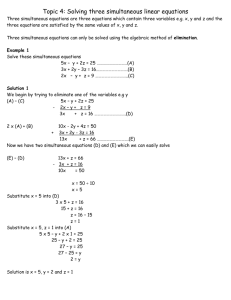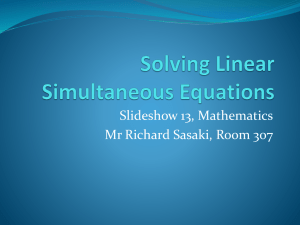Topic 3: Solving two simultaneous linear equations
advertisement

Topic 3: Solving two simultaneous linear equations Two simultaneous equations are two equations which contain 2 variables e.g. x and y and the two equations are both satisfied by the same values of x and y. There are two different methods to solve simultaneous equations. (1) Graphical method The straight line corresponding to each equation is drawn. Where the straight lines intersect is the solution of the two simultaneous equations. Example 1 Use a graphical method to solve this pair of simultaneous equations; 5x + 2y = 20 Y = 2x + 1 Solution 1 5x + 2y = 20 When x = 0 5 x 0 + 2y = 20 2y = 20 y = 20 ÷ 2 y = 10 (0,10) y = 2x + 1 When x = 0 y=2x0+1 y=1 (0,1) When y = 0 5x + 2 x 0 = 20 5x = 20 x = 20 ÷ 5 x=4 (4,0) When y = 0 0 = 2x + 1 -1 = 2x -1 ÷ 2 = x -0.5 = x (-0.5,0) Plot these two lines (see graph paper) The solution lies where these two lines intersect Solution is x = 2, y = 5 Simultaneous equations with no solution Sometimes when the straight lines corresponding to the two simultaneous equations are drawn, the lines are parallel so they do not intersect. This means that there is no solution. Example 2 Use a graphical method to show that this pair of simultaneous equations do not have a solution; y – 2x = 4 2y = 4x – 1 Solution 2 y – 2x = 4 When x = 0 y–2x0=4 y=4 (0,4) 2y = 4x – 1 When x = 0 2y = 4 x 0 – 1 2y = -1 y = -1 ÷ 2 y = -0.5 (0,-0.5) When y = 0 0 – 2x = 4 -2x = 4 x = 4 ÷ -2 x = -2 (-2,0) When y = 0 2 x 0 = 4x - 1 0 = 4x - 1 1 = 4x 1÷4=x 0.25 = x (0.25,0) See graph paper (2) Algebra method We can also solve two simultaneous equations using the algebra method known as elimination. Case 1: If the numbers in front of the x or y terms are the same size but different signs in both equations, the equations are added to get rid of the x or y terms. Example 1 Solve the simultaneous equations 2x – y = 5 ……………..(A) 3x + y = 10 …………….(B) Solution 1 (A) + (B) 2x – y = 5 + 3x + y = 10 5x = 15 x = 15 ÷ 5 x=3 Substitute x = 3 into (A) 2x3–y=5 6–y=5 6–5=y 1=y Solution is x = 3, y = 1 Case 2: If the numbers in front of the x and y terms are the same in both equations the equations are added to get rid of the x or y terms. Example 2 Solve the simultaneous equations 3x + y = 5 …………………(A) 3x – 2y = 8 …………………(B) Solution 2 (A) – (B) 3x + y = 5 - 3x – 2y = 8 3y = -3 y = -3 ÷ 3 y = -1 Substitute y = -1 into (A) 3x – 1 = 5 3x = 5 + 1 3x = 6 x=6÷3 x=2 Solution is x = 2, y = -1 Case 3: If the number in front of the x or y terms are not the same size in both equations but they can be made the same by multiplying one equation by a suitable number we must multiply to make the x or y term the same size then add or subtract the equations as necessary. Example 3 Solve these simultaneous equations 5x + 2y = 17 …………………….. (A) 3x – y = 8 …………………………(B) Solution 3 2 x (B) gives (A) + (C) 6x – 2y = 16 ……………………….(C) 5x + 2y = 17 6x – 2y = 16 11x = 33 x = 33 ÷ 11 x=3 Substitute x = 3 into (A) 5 x 3 + 2y = 17 15 + 2y = 17 2y = 17 – 15 2y = 2 y=2÷2 y=1 Solution is x = 3, y = 1 Case 4: If the numbers in front of the x or y terms are not the same size in both the equations they can be made the same size by multiplying both of the equations by suitable numbers then add or subtract the numbers as necessary. Example 4 Solve these simultaneous equations 2x + 3y = 2 ………………………..(A) 3x – 4y = 20 ………………………(B) Solution 4 3 x (A) gives 2 x (B) gives (C) – (D) 6x + 9y = 6 ………………………….(C) 6x – 8y = 40 ………………………..(D) 6x + 9y = 6 - 6x – 8y = 40 17y = -34 y = -34 ÷ 17 y = -2 Substitute y = -2 into (A) 2x + 3 x -2 = 2 2x – 6 = 2 2x = 2 + 6 2x = 8 x=8÷2 x=4 Solution is x = 4, y = -2







